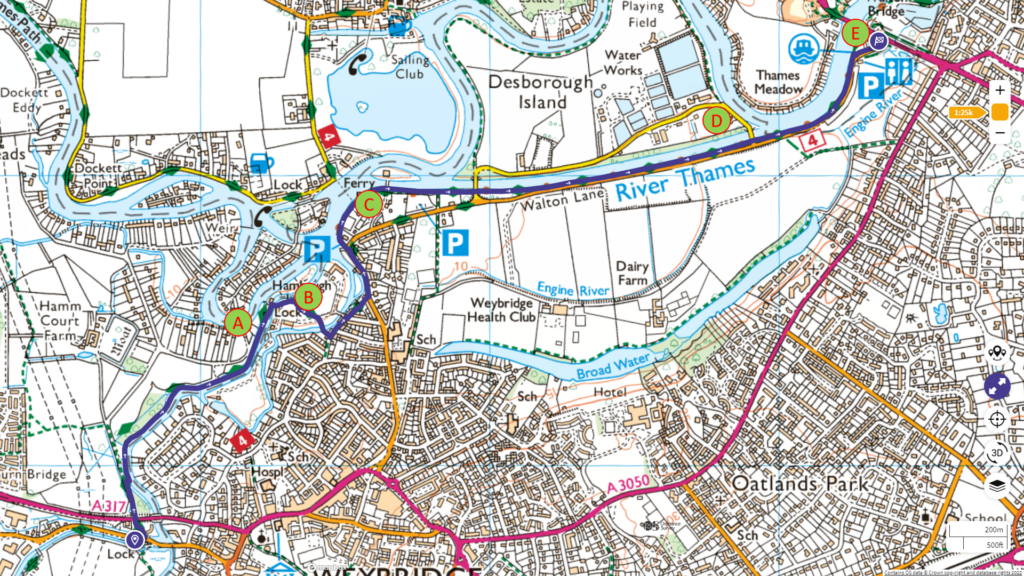A morning walk in the drizzle from Weybridge, passing some quaint islands toward the confluence of the Thames and Wey River.
The route map is available on Follow the entire walk on

B: Hamhaugh Island
C:Thames and Wey River confluence
D: Desborough Island
E: Walton Road Bridge
A: Thames Lock
Thames Lock, located near the confluence of the Wey Navigation and the Thames River, is known for its challenging operation as described by J.B. Dashwood in 1868. The lock-keeper, noted for his helpfulness, would provide a “magic wand” (likely a crowbar or similar tool) to navigate the lock, a task that requires caution due to the risk of injury or falling into the water. The operation involves sitting astride the gate, using the tool to open the hatches by placing it in the niches and applying force, a process made difficult by the stiffness of the hatches.
Opened in 1653 and rebuilt in 1863 using concrete, an innovative material at the time, Thames Lock has demonstrated remarkable durability, requiring little renovation even after more than a century of use. The lock, with a 2.59m rise, is located just 200 metres from the Thames, featuring a lock-keeper’s cottage and a small visitor center in the old stables, reflecting its historical and operational significance in river navigation. Learn more
B: Hamhaugh Island
Hamhaugh Island, historically known as Stadbury, is located in the River Thames, south of Shepperton Lock in Shepperton, Surrey, England. The island is near the southernmost point of the Thames and features a garden-lined southern curve known as Hamhaugh Point. It measures approximately 690 meters in length and 100-120 meters in width, positioned close to the urban resources of Weybridge and Shepperton.
The island is residential, with 46 houses and a communal green, alongside a patch of woodland. Access is via boat or by foot/bicycle from Shepperton Lock, crossing Lock Island and a weir. There’s also a ferry service linking Shepperton Lock to Weybridge, facilitating access to the Thames Path National Trail.
Hamhaugh Island’s history involves alterations for navigational improvements on the Thames, including the creation of nearby Lock Island and modifications to manage flooding. In the 18th century, breaches in the island’s banks were repaired by the City of London authorities, who also addressed illegal fishing activities in the area. Learn more
C: Thames and Wey River confluence
The Thames River plays a crucial role in the Wey Valley, primarily because the navigations along both the Thames and the Wey depended on the riverborne cargos for their economic viability. The River Wey, a significant tributary, meets the Thames near Weybridge. The history and impact of the Thames are vast, though briefly highlighted here in relation to its importance to navigation and the surrounding area.
Notable mentions include a personal anecdote from a blogger in July 2006, who enjoyed swimming in the Thames, and an environmental initiative in September 2008, where a large flotation boom was tested near Weybridge to prepare for potential environmental disasters by containing spills.
The River Thames, with its source at Trewsbury Mead in the Cotswolds, flows over 215 miles and is fed by 38 main tributaries, including the River Wey. It has a significant catchment area of 5,924 square miles and becomes tidal below Teddington Weir, covering the last 68 miles of its journey to the sea, highlighting its role as England’s major river by volume and its ecological and historical significance to the region.
D: Desborough Island
Desborough Island is a man-made island formed by the Desborough Cut, an artificial channel created to improve navigation on the River Thames. The channel, opened in 1935, bypasses a large meander in the river between Weybridge and Walton-on-Thames, Surrey, England. The island is characterized by its tranquility, natural beauty, and is accessible via small bridges at either end. It offers a unique diversion for walkers and cyclists on the Thames Path, featuring meadows, trees, and a path that allows visitors to explore its perimeter. Learn more
E: Walton Road Bridge
Walton Bridge crosses the River Thames in Surrey, connecting Walton-on-Thames and Shepperton. The bridge has a history of several iterations, with the most recent one being a modern structure that replaced the old, deemed unsafe bridge. The current Walton Bridge, which opened in 2013, features a sleek, contemporary design with concrete elements, distinct from the historical bridges often associated with the River Thames. This modern bridge is noted for its functionality and contrast to the traditional architectural styles found along the river.

